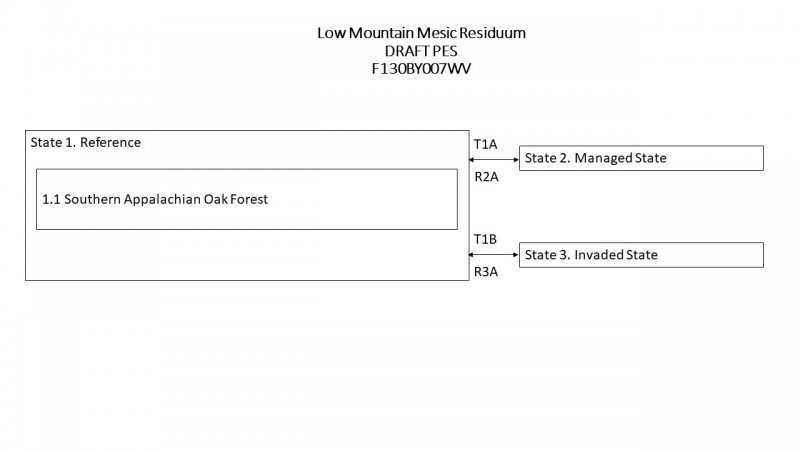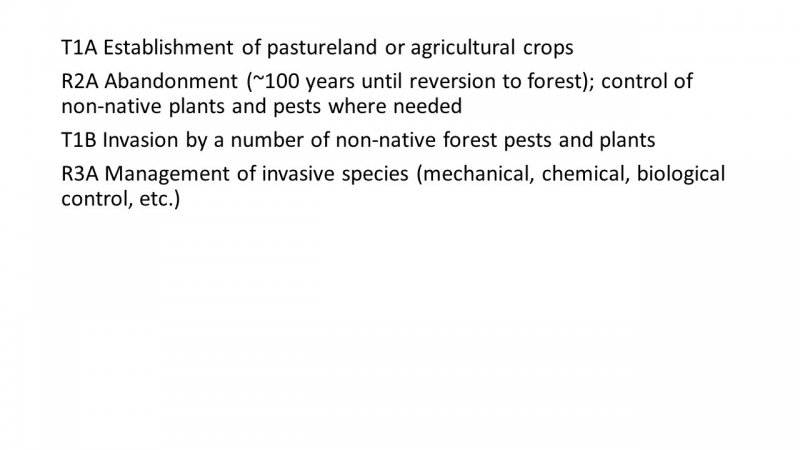Ecological dynamics
The vegetation groupings described in this section are based on the terrestrial ecological system classification developed by NatureServe (Comer et al. 2003). Ecological systems represent recurring groups of biological communities that are found in similar physical environments and are influenced by similar dynamic ecological processes, such as fire or flooding. They are intended to provide a classification unit that is readily mappable, often from remote imagery, and readily identifiable by conservation and resource managers in the field.
Provisional Ecological Sites are intended to be very broad and should be considered first approximations based on existing available data. This PES covers multiple ecological systems. The ecological system defined by NatureServe that most likely approximates the reference community of this PES across the largest acreage based on spatial analysis is Southern Appalachian Oak Forest. However, pine forests may be an important component within the reference community as well, potentially depending on fire and/or insect outbreaks. Further field investigation is needed to determine whether that should be incorporated into the reference community. For the sake of simplicity, and due to the lack of field-based knowledge, only Southern Appalachian Oak Forest is included in the State and Transition Model as the reference community. This could be addressed as needed in future projects.
This (following) information is provided by NatureServe (www.natureserve.org) and its network of natural heritage member programs, a leading source of information about rare and endangered species, and threatened ecosystems.
Southern Appalachian Oak Forest: “These forests are dominated by Quercus species, most typically Quercus alba, Quercus coccinea, Quercus prinus, Quercus rubra, and Quercus velutina with varying amounts of Acer rubrum, Carya spp., Fraxinus americana, Nyssa sylvatica, and other species. Less typical are stands dominated by other hardwood species, or by Pinus strobus. Historically, Castanea dentata was a dominant or codominant in many of these communities until its virtual elimination by the chestnut blight fungus (Cryphonectria parasitica) during the early 1900s. Subcanopies and shrub layers are usually well-developed. Some areas (usually on drier sites) now have dense evergreen heath shrub layers of Kalmia latifolia, with Rhododendron maximum on more mesic sites. Some other areas have deciduous heath-dominated layers, sometimes consisting of Vaccinium spp. or Gaylussacia spp. Herbs, forbs and ferns are usually sparse to moderate in density.
Dynamics: This system is naturally dominated by stable, uneven-aged forests. Extreme wind or ice storms occasionally create larger canopy openings. Natural old-growth forest examples have trees reproducing in small to medium-sized canopy gaps created by the death of individual or small groups of trees. Fire occurred fairly frequently in presettlement times, though there is some dispute whether most of the fires were natural or anthropogenic in origin (Abrams 1992, Delcourt and Delcourt 1997). Fires were usually low-intensity surface fires. The dominant species are fairly fire-tolerant, making most fires non-catastrophic. Fire may be important for favoring oak dominance over more mesophytic tree species within some of the topographic range of this system. Fire also can be expected to have a moderate effect on vegetation structure, producing a somewhat more open canopy and less dense understory and shrub layer than currently seen in most examples. Fire frequency or intensity may be important for determining the boundary between this system and both the more mesic and the drier systems. Virtually all examples have been strongly affected by the introduction of the chestnut blight, which killed all of the Castanea dentata trees, eliminating it as a canopy dominant. Past logging affected most occurrences. Regenerated forest canopies are even-aged, or have a more even-aged structure. Extreme wind or ice storms occasionally create larger canopy openings, which may provide particularly good sites for Quercus regeneration. Virtually all examples have been strongly affected by introduction of chestnut blight (Cryphonectria parasitica), which killed Castanea dentata trees, eliminating it as a canopy dominant. The introduction, and now widespread establishment, of gypsy moth (Lymantria dispar) that favors oaks as food has also affected these forests by causing widespread mortality of overstory trees depending on topographic position and precipitation amounts around defoliation events. Past logging, and now lack of fire, has affected most occurrences by changing canopies to an even-aged, or more even-aged, structure with an understory of shade-tolerant but fire-intolerant species such as Pinus strobus, Acer rubrum, and Acer pensylvanicum. The removal of Castanea dentata from the overstory of these forests is thought to have benefited Carya spp., and their persistence and continued recruitment in contemporary oak-hickory forests may reflect fire exclusion in recent decades. (This) occurs as a large-patch to matrix system. Contiguous areas of tens of thousands of acres once occurred. The oak forests probably make up slightly more than 50% of the landscape in all but the higher elevations of the region. Size of existing occurrences may be strongly affected by separation distances for occurrences. A few remaining occurrences over 10,000 acres are probably present.”
Description Author: M. Schafale, R. Evans, M. Pyne, R. White, S.C. Gawler Version: 29 Apr 2016
Spatial analysis of existing vegetation maps suggests that agricultural use (pasture/hay) is very important on this site. Additionally, a portion of it classifies as urban/open space. A review of USDA-NRCS Official Series Descriptions (OSDs) for the soils included in this site confirm that and additionally describe some cropland such as corn, burley tobacco, small grains and vegetable crops.
State 1
Reference - Southern Appalachian Oak Forest
The reference state includes one major NatureServe ecological systems as described previously, Southern Appalachian Oak Forest. Oaks now dominate this site where American chestnut once would have been a major species dominant in the canopy. Invasive, non-native forest pests and pathogens such as American chestnut blight, dogwood anthracnose, and European gypsy moth (among others) are a threat to this PES. Reference conditions still exist on this site but much of it has also been converted to agriculture or urbanized.
State 2
Managed State
Pasture and hay are very important and common land-uses on this site. In addition, some crops are grown including corn, burley tobacco, small grains and vegetable crops.
State 3
Invaded State
Where reference conditions still exist, non-native forest pests pose a threat. Where pasture or crops exist, non-native plant species and weedy natives can become problematic. The impact and response varies by species (both of the host and the invader) but often will include combinations of mechanical, biological, chemical and cultural control. Tree breeding programs for genetic resistance and germplasm conservation may be important considerations, especially in front an incoming invasion if reforestation is planned after it passes. It is always best if local genetic material can be used if restoration efforts are attempted.
Transition T1A
State 1 to 2
Conversion to pasture or agricultural crops
Transition T1B
State 1 to 3
Invasion by any number of non-native forest pests and plants
Restoration pathway R2A
State 2 to 1
Abandonment (~100 years until reversion to forest); control of non-native plants and pests where needed
Restoration pathway R3A
State 3 to 1
Management of invasive species (mechanical, chemical, biological control, etc.)


